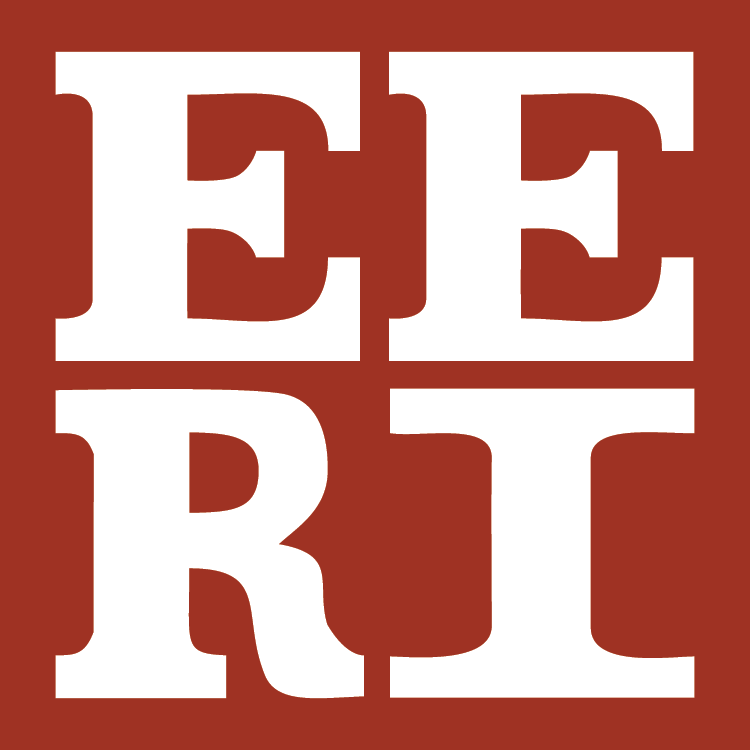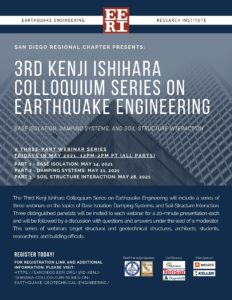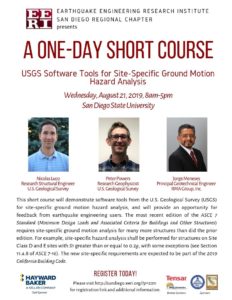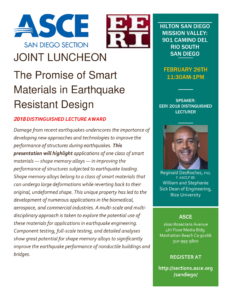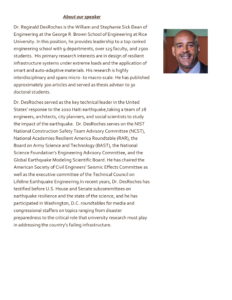Speaker Information: 3rd Kenji Ishihara Colloquium Series on Earthquake Geotechnical Engineering
Base Isolation, Damping Systems, and Soil-Structure Interaction
Speakers and Abstracts
Ian Aiken, Ph.D., P.E.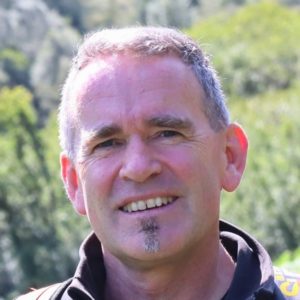
Principal, Seismic Isolation Engineering, Inc.
Seismic Damping: An Overview of Device Types, Design and Code Considerations
Abstract: Ian will give a snapshot overview of some of the different types of seismic damping devices and applications in the U.S. and internationally, the main aspects of the ASCE 7 and ASCE 41 requirements for structures with damping systems, and discuss some of the engineering and implementation considerations for using seismic dampers that differ from more typical building design, such as analysis requirements, the need for device testing, and the peer review process.
Bio: Ian Aiken is a Principal with Seismic Isolation Engineering, Inc., in Berkeley, California, and has more than 30 years of experience in earthquake, structural and civil engineering. He holds a Bachelor of Engineering degree from the University of Auckland, New Zealand, and Masters and Doctoral degrees in Civil Engineering from the University of California, Berkeley. His particular areas of expertise are seismic isolation and passive energy dissipation for seismic structural control, and the use of nonlinear analysis methods for structural analysis. He has worked on nearly 100 seismic isolation and energy dissipation projects including many notable building, bridge and industrial structures worldwide. For more than 20 years Ian has been extensively involved in the development, testing and implementation of buckling-restrained braces in the U.S., with notable firsts including the first project in the U.S., the first hospital in California and the U.S., the first bridge in the U.S. to use BRBs, and recently the Wilshire Grand Tower in Los Angeles.
Ian has been a member of state and national committees on isolation and energy dissipation, including ASCE, AASHTO and SEAONC committees, and FEMA-BSSC for the NEHRP national provisions.
Jay Love
 Senior Principal, Degenkolb Engineers
Senior Principal, Degenkolb Engineers
Seismic Design with Viscous Dampers: Retrofit Design Strategies
Abstract: One of the largest hospital facilities constructed in recent years in California, the new Sutter Health California Pacific Medical Center Van Ness Campus Hospital opened to patients on March 2, 2019.The $2.1B project produced a 13-story, 989,230 square foot hospital, including patient beds, diagnostic and treatment centers, and subterranean parking. Van Ness Campus Hospital consolidated the acute care services of two older Sutter Health California Pacific Medical Center (CPMC) campuses to create their flagship San Francisco hospital.
The structural system features a steel moment resisting frame with supplemental viscous wall dampers to reduce earthquake forces. Originally developed and implemented in Japan over the past three decades, this project marked the first application of viscous wall dampers in the United States. Through testing and nonlinear response history analysis, viscous wall dampers are expected to absorb nearly 90 percent of the earthquake energy at the Design Earthquake level.
Bio: Jay Love has more than 40 years of experience, including master planning, structural design, seismic evaluation, and retrofit design. He has considerable expertise in designing specialized buildings, particularly large and complex healthcare facilities. Jay’s notable projects include the new design of the new Sutter Health California Pacific Medical Center (CPMC) Hospital at Van Ness and Geary and the Kaiser Permanente, Los Angeles Replacement Hospital. Jay has overseen and served as project mentor on numerous healthcare projects for Stanford Health Care ValleyCare Medical Center – Pleasanton and Livermore, Stanford Hospital, Catholic Healthcare West, Kaiser Foundation Hospitals, Dignity Health, and Sutter Health.
Aaron Malatesta, P.E.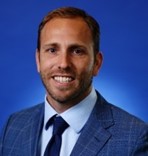
Structural Engineer
Seismic Design with Viscous Dampers: Retrofit Design Strategies
Abstract: Structural engineers have been using viscous dampers to protect new and existing building structures from seismic excitation for almost 30 years. There are a number of different types of damping applications, and the primary objective of this presentation will be to demonstrate the basic principles for supplemental viscous damping and how they can be applied for seismic retrofit of pre-Northridge steel moment frames and nonductile concrete moment frames. The presentation will include historical background and an overview of preliminarydesign concepts and simplified design procedures. Examples will be presented and alternative methods for construction detailing will be discussed.
Bio: Aaron Malatesta, P.E. is a structural engineering consultant in the field of energy dissipation devices and advanced seismic design. Mr. Malatesta graduated from Stanford University with a Masters degree in Structural Engineering. He has practiced structural engineering for consulting firms focused on both buildings and transportation infrastructure. As a licensed professional engineer in the state of California, he has been involved in the design and retrofit of a number of different types of structures. He has worked as a technical director for a viscous damper manufacturer leading the development of technical publications, management of research and development activities, and working with engineers to improve the performance of structures using viscous damping systems. He is actively involved in ASCE 7 and ASCE 41 committees for seismic isolation systems and energy dissipation devices.
3rd Kenji Ishihara Colloquium Series on Earthquake Geotechnical Engineering
Base Isolation, Damping Systems, and Soil-Structure Interaction
The Third Kenji Ishihara Colloquium Series on Earthquake Engineering will include a series of three webinars on the topics of Base Isolation, Damping Systems, and Soil-Structure Interaction. Three distinguished panelists will be invited to each webinar for a 20-minute presentation each and will be followed by a discussion with questions and answers under the lead of a moderator. This series of webinars target structural and geotechnical structures, architects, students, researchers, and building officials.
Click image on right to view event flyer.
PROGRAM
Webinar 1: Friday, May 14th, 2021, 12pm-1:45pm PDT
Base Isolation (Moderator: Professor Gilberto Mosqueda)
Click here to view a replay of this webinar.
Panelist 1 – Michael C. Constantinou, University at Buffalo, Testing of Seismic Protective System Hardware: Significance, Scaling and Similarity
Panelist 2 – Reid Zimmerman, KPFF, Changes in ASCE 7-22 for Seismically Isolated Structures and Recent KPFF Base-Isolated Projects
Panelist 3 – Simon Rees, Arup
Panelist 4 – Henry Tatham, Beca, Refurbishing a Base Isolated World First
Webinar 2: Friday, May 21st, 2021, 12pm-1:30pm PDT
Damping Systems (Moderator: Alvaro Celestino)
Click here to view a replay of this webinar.
Panelist 1 – Jay Love, Degenkolb Engineers, Application of Viscous Wall Dampers in the US
Panelist 2 – Ian Aiken, SIE Inc., Seismic Damping: An Overview of Device Types, Design and Code Considerations
Panelist 3 – Aaron Malatesta, Structural Engineer, Seismic Design with Viscous Dampers: Retrofit Design Strategies
Webinar 3: Friday, May 28th, 2021, 12pm-1:30pm PDT
Soil-Structure Interaction (Moderator: Jorge Meneses)
Click here to view a replay of this webinar.
Panelist 1 – Jonathan Stewart, UCLA, Seismic Earth Pressures on Retaining Walls based on SSI Principles
Panelist 2 – Bret Lizundia, Rutherford & Chekene, A Practical Guide to Soil-Structure Interaction
Panelist 3 – Sissy Nikolau, NIST, SSI and Functional Recovery
REGISTRATION
Click here to register for the colloquium.
Registration Fees
*EERI Student Members and EERI, ASCE, & SEOSD Members – Free
*Non-Members – $20/webinar or $40/three webinars
*Retired, Public Employees – $10/webinar or $20/three webinars
PDH Certificates will be issued upon request.
EERI San Diego Chapter Webinar Series
NEW AND REVISED ALQUIST-PRIOLO EARTHQUAKE FAULT ZONES IN SAN DIEGO
Tuesday, April 6th, 2021
12pm-2pm PDT
Virtual Webinar
On February 18, 2021, the California Geological Survey (CGS) released preliminary review maps of proposed new and revised Alquist-Priolo Earthquake Fault Zones to the City and County of San Diego (https://www.conservation.ca.gov/cgs/preliminary-releases). The City of San Diego has also posted the announcement here: https://www.sandiego.gov/sites/default/files/2021-02-26_earthquake_zones.pdf
The February 18, 2021 release date begins a 90-day public comment period to provide technical review comments on the proposed Earthquake Fault Zone maps. Comments should be sent to the State Mining and Geology Board before May 19th, 2021, and should be addressed to:
Jeffrey Schmidt, Executive Officer
State Mining and Geology Board
801 K Street, MS 20-15
Sacramento, CA 95814-3528
Email: smgb@conservation.ca.gov
Phone: (916) 322-1082
The State Mining and Geology Board (SMGB) will hold a public hearing near the end of the 90-day review period. For more information on the date and location of the public hearing, contact the SMGB by visiting www.conservation.ca.gov/smgb.
The EERI San Diego Chapter is organizing a webinar to provide background and further information on these new and revised maps. This free virtual webinar will be presented on Tuesday, April 6th, 2021 from 12pm-2pm with the following invited speakers:
1) Prof. Thomas Rockwell (San Diego State University)
2) Timothy Dawson (California Geological Survey)
3) Michael DeFrisco (California Geological Survey)
4) Discussion Q&A. Moderator: Dr. Jorge Meneses
ASCE EERI Joint Luncheon 2021
WHAT’S NEXT FOR THE SAN DIEGO EARTHQUAKE SCENARIO? PRE- AND POST-DISASTER LESSONS ON BUILDING COMMUNITY RESILIENCE
Tuesday, February 23rd, 2021
12:00pm-1:30pm
Virtual Meeting
Join EERI in a joint luncheon with ASCE San Diego Section, featuring guest speaker Dr. Laurie Johnson, EERI President. The presentation will discuss the use of smart materials in bettering structural performance against seismic activity.
For members of EERI and ASCE = FREE
For non-members = $20.00
For public agency workers = $10.00
For more information, click the image to the right to view the event flyer.
REGISTRATION
Click here to register for the luncheon.
Registration closes on Monday, February 22, 2021 at 5pm PST.
EERI San Diego Chapter Webinar Series
APPLYING LESSONS LEARNED FROM COVID-19 TO EARTHQUAKE PREPAREDNESS
Global pandemics and large earthquakes are both events that have a low frequency of occurrence, but a high risk for loss of life and economic losses. As a result, our current experiences with COVID-19 can be useful for discussions about preparing for these “low frequency/high risk” events. Although currently our scientific knowledge and technology are better than they have ever been, in the past six months, COVID-19 has posed challenges for the world despite attempts to prepare for events such as this. This webinar series looks at how scenarios are used as a planning tool, what challenges can be encountered in preparing for events such as these, and what next steps can be taken for earthquake preparedness in our community.
Webinar 1: Friday, October 16th, 2020, 12:00pm PDT (day before anniversary of Loma Prieta Earthquake)
Using Scenarios for Preparedness: Comparing Pandemics and Earthquakes
View Recording of Webinar
Abstract: Scenarios are useful planning tools to help us prepare for future events, particularly events that have a low frequency of occurrence but a high risk of losses associated with them, such as large earthquakes and global pandemics. Several public health scenarios were developed in recent years to better understand and prepare for a global pandemic, prior to the COVID-19 pandemic. This webinar discusses the outcomes and conclusions of these scenarios, a comparison to our current experiences with COVID-19, and a comparison to existing earthquake scenarios and what we can learn from them in an effort to improve earthquake preparedness.
Webinar 2: Friday, October 30th, 2020, 12:00pm PDT
Common Challenges Preparing for Low Frequency/High Risk Events (Earthquakes and Pandemics)
View Recording of Webinar
Abstract: Preparing and planning for events that have a low frequency of occurrence but high risk of loss associated with them can have a number of obstacles that must be overcome in order to achieve success. These obstacles include changing public perception of risk, communicating information to a non-scientific population, and obtaining sustained political and financial support, amongst many others. These challenges are discussed in the context of our current experiences, and how those same challenges are encountered in planning for earthquakes and developing more seismically resilient communities. This webinar will also discuss some of the ways in which these challenges can be overcome by learning from the failures and successes of our experiences with COVID-19.
Webinar 3: Friday, November 13, 2020, 12:00pm PST
Next Steps for Earthquake Preparedness in Our San Diego Community
View Recording of Webinar
Abstract: Developing communities that are more earthquake resilient and better prepared for large disasters takes time, resources, and lots of planning. This webinar will focus on how to prepare in our community by looking at outreach, developing a group of stakeholders, and identifying short-term and long-term goals for San Diego. This webinar is intended to be more interactive, with discussion amongst stakeholders. The basis for this discussion will be the San Diego Earthquake Scenario released in March 2020, before the pandemic hit the San Diego region.
SPEAKERS
Jorge F. Meneses, Ph.D., P.E., G.E.,D.GE, F.ASCE, Principal Geotechnical Engineer, RMA Group, Inc.
San Diego, CA
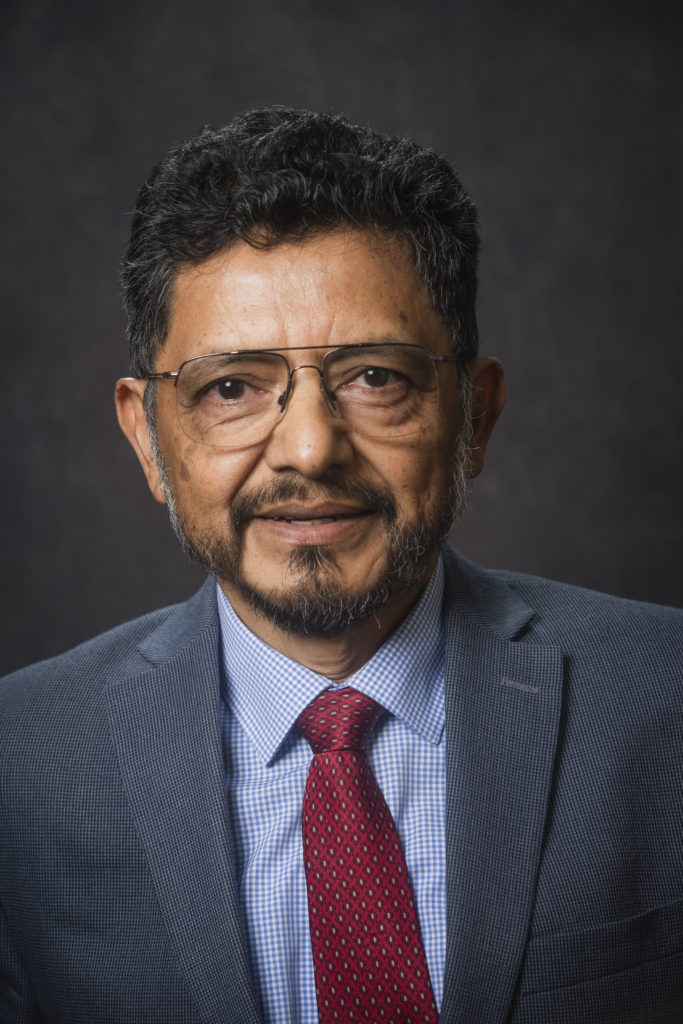 Jorge F. Meneses, Ph.D., P.E., G.E., D.GE, F.ASCE, Principal Geotechnical Engineer, RMA Group, Inc., has more than 30 years of consultancy, project management, research, and teaching experience, in both private industry and research institutions in the field of geotechnical and earthquake engineering. He has been involved in numerous projects serving as a technical lead in geotechnical earthquake engineering and foundation engineering across the country and various markets including water, nuclear, transportation, high rise buildings, energy, schools, hospitals, commercial and industrial.
Jorge F. Meneses, Ph.D., P.E., G.E., D.GE, F.ASCE, Principal Geotechnical Engineer, RMA Group, Inc., has more than 30 years of consultancy, project management, research, and teaching experience, in both private industry and research institutions in the field of geotechnical and earthquake engineering. He has been involved in numerous projects serving as a technical lead in geotechnical earthquake engineering and foundation engineering across the country and various markets including water, nuclear, transportation, high rise buildings, energy, schools, hospitals, commercial and industrial.
Dr. Meneses frequently acts as a peer reviewer for technical conferences and technical journal publications, is a guest speaker for domestic and international conferences, and has published more than 60 technical publications. He is currently a part-time faculty member in the graduate school of San Diego State University. He is the President and Founder of the Earthquake Engineering Research Institute (EERI) San Diego Chapter, California Seismic Safety Commissioner, Honorary Chair of the ASCE Geo-Institute San Diego Chapter, Member of the ASCE 7-16 (Minimum Design Loads for Buildings and Other Structures) and ASCE 1 (Geotechnical Analysis, Design, Construction, Inspection and Monitoring of Nuclear Safety-Related Structures) Committees, member of the Industry Advisory Board, Department of Structural Engineering (University of California San Diego), member of the Academy of Geo-Professionals, and a Fellow of the American Society of Civil Engineers (ASCE).
Kristen Chang, P.E., Senior Geotechnical Engineer, Group Delta
San Diego, CA
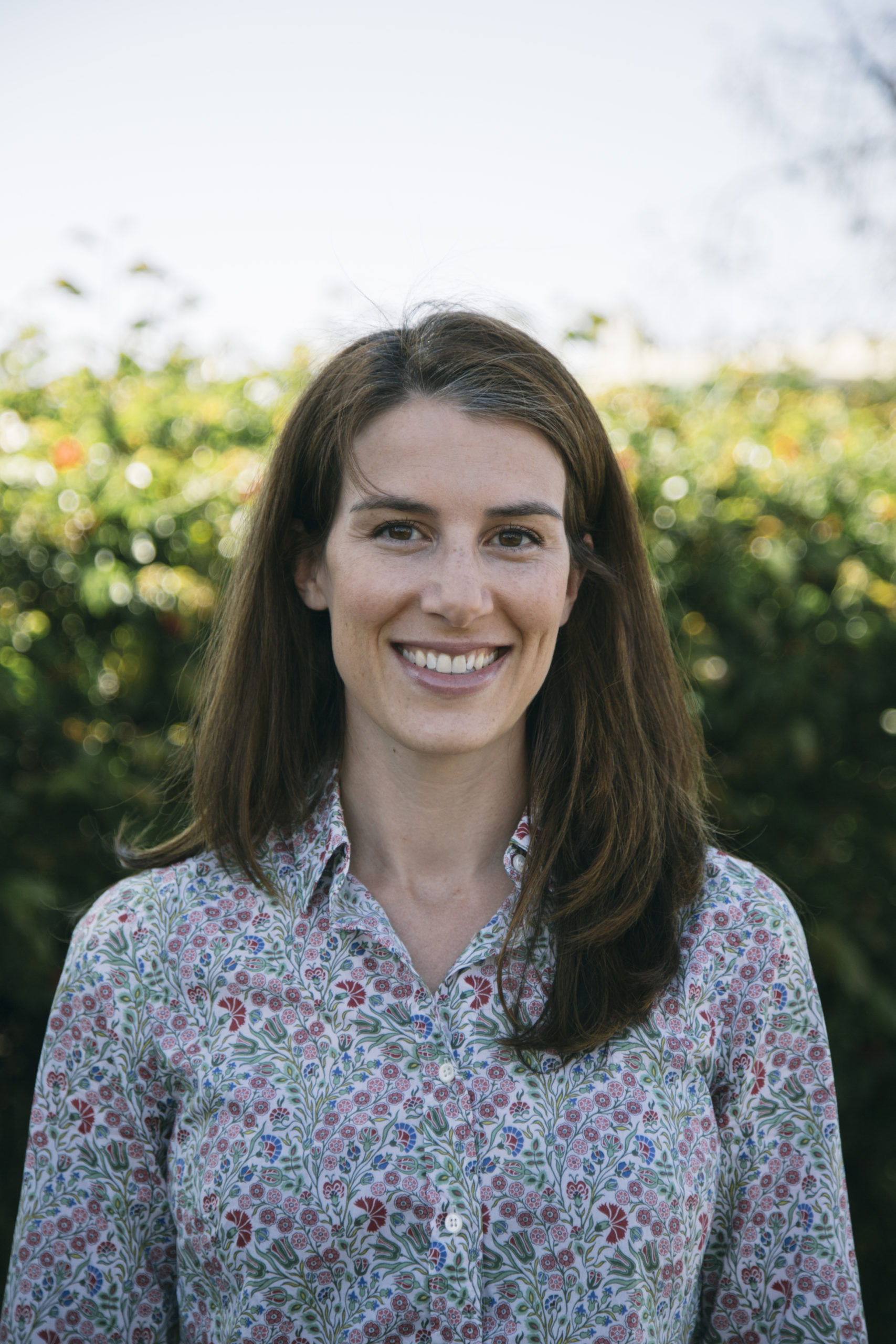 With over 12 years of experience, Ms. Chang has worked on a broad range of projects in the field of geotechnical engineering. Her areas of expertise include design of foundations and earth retaining structures, and geomechanical numerical modeling and analyses. She has performed geotechnical forensic evaluations for landslides and repair of failed slopes; structural distress induced by seismic events and other adverse geologic conditions; performance of floor level studies, foundation condition surveys, and crawlspace observations for damage assessments.
With over 12 years of experience, Ms. Chang has worked on a broad range of projects in the field of geotechnical engineering. Her areas of expertise include design of foundations and earth retaining structures, and geomechanical numerical modeling and analyses. She has performed geotechnical forensic evaluations for landslides and repair of failed slopes; structural distress induced by seismic events and other adverse geologic conditions; performance of floor level studies, foundation condition surveys, and crawlspace observations for damage assessments.
David Harrison, Assistant Director for Emergency Services, City of Carlsbad
Carlsbad, CA
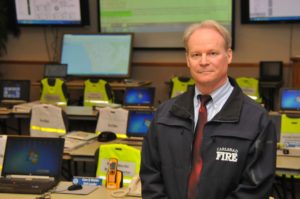 David Harrison is the Emergency Preparedness Manager for the City of Carlsbad, a position he has held for twelve years. David coordinated the city’s response to the 2007 San Diego County Firestorm, the 2010 H1N1 flu pandemic, and 2011 regional power outage. He provided response support during an active shooter attack in 2010. During the 2014 Poinsettia Wildfire which ravaged Carlsbad, he coordinated evacuations, sheltering and incident response support operations from Carlsbad’s EOC. During the 2017 Lilac Wildfire, he coordinated evacuation and sheltering support for neighboring jurisdiction evacuees.
David Harrison is the Emergency Preparedness Manager for the City of Carlsbad, a position he has held for twelve years. David coordinated the city’s response to the 2007 San Diego County Firestorm, the 2010 H1N1 flu pandemic, and 2011 regional power outage. He provided response support during an active shooter attack in 2010. During the 2014 Poinsettia Wildfire which ravaged Carlsbad, he coordinated evacuations, sheltering and incident response support operations from Carlsbad’s EOC. During the 2017 Lilac Wildfire, he coordinated evacuation and sheltering support for neighboring jurisdiction evacuees.
David is Carlsbad’s representative to the San Diego County Unified Disaster Council and is an InfraGard San Diego Board Member. He is originator of Carlsbad CERT and co-founder of the Ready Carlsbad Business Alliance. David has served on the Advisory Board of, and taught in, National University’s Homeland Security and Emergency Management Program. He is a Past-President of the Carlsbad Hi-Noon Rotary Club.
David is a U.S. Navy Captain, retired. He commanded a warship, coordinated development of the Navy’s Antiterrorism and Force Protection Program, served as Navy representative to the FBI’s TWA 800 Joint Terrorism Task Force investigation, and developed the Concept of Operations for early warning, and missile and civil defense against Iraq’s SCUD missiles for the Government of Israel during the first Gulf War.
Ryan DeHart, Emergency Services Coordinator, County of San Diego Office of Emergency Services
San Diego, CA
Ryan joined the county as an Emergency Services Coordinator with the County of San Diego, Office of Emergency Services in February of 2018. His projects include overseeing and administering updates to the Multi-Jurisdictional Hazard Mitigation Plan, Earthquake, Tsunami, and Severe Weather Coordination, Medical/Health Liaison, Lifelines Coordinator, Spontaneous Volunteer Coordinator, and Intern Coordinator. In addition, Ryan also does collaborative work within Reunification Planning. Previously, Ryan worked as an Emergency Services Specialist with the County of San Benito, Public Health Services From June 2015 – January 2018, where he worked within communicable disease response and readiness, mass prophylaxis planning, hospital protection and healthcare readiness, exercise & training coordination, and regional collaboration within the Bay Area. Ryan has been involved in numerous responses including fulfilling EMMA requests to Napa County during the 2015 Atlas Fire (Tubbs/Atlas Complex), 2017 San Benito County Floods, and the 2018 West Fire. Ryan received his B.A. in United States Politics in 2015 from the University of Santa Cruz, where he also interned for the County of Santa Cruz Office of Emergency Services under their OES Manager, Paul Horvat.
ORGANIZING COMMITTEE
Chair: Dr. Jorge Meneses
Janna Bonfiglio
Alvaro Celestino
Kristen Chang
Octavio Cortes Macouzet
Maryam Motamed
Tasneem Sadeque
2nd Kenji Ishihara Colloquium Series on Earthquake Geotechnical Engineering
“Seismic Lateral Displacements”
Thursday & Friday, August 22-23, 2019
San Diego State University
San Diego, CA
 The second of this colloquium series, honoring Professor T. Leslie Youd, will focus on seismic lateral displacements and will take place at San Diego State University on Thursday & Friday, August 22-23 from 8am to 5pm. The topics that will be presented on during the colloquium are oriented towards geotechnical engineers, structural engineers, engineering geologists, architects, civil engineers, researchers, and students. 22 speakers, consisting of geotechnical and structural engineers, set to present at this colloquium include Prof. T. Leslie Youd, Prof. Kenji Ishihara, Prof. Thomas O’Rourke, Prof. Liam Finn, Prof. Jonathan Bray, Prof. Masanori Hamada, and other engineers and professors from the United States, Canada, Japan, Mexico, and Chile.
The second of this colloquium series, honoring Professor T. Leslie Youd, will focus on seismic lateral displacements and will take place at San Diego State University on Thursday & Friday, August 22-23 from 8am to 5pm. The topics that will be presented on during the colloquium are oriented towards geotechnical engineers, structural engineers, engineering geologists, architects, civil engineers, researchers, and students. 22 speakers, consisting of geotechnical and structural engineers, set to present at this colloquium include Prof. T. Leslie Youd, Prof. Kenji Ishihara, Prof. Thomas O’Rourke, Prof. Liam Finn, Prof. Jonathan Bray, Prof. Masanori Hamada, and other engineers and professors from the United States, Canada, Japan, Mexico, and Chile.
Registration includes breakfast, lunch, and refreshments during the breaks.
Click here for information on each speaker and their presentations.
Click the image on the right to view event flyer.
PROGRAM
THURSDAY, AUGUST 22
Opening Ceremony
| Registration and Breakfast | 7:00am | 8:00am |
| EERI | 8:00am | 8:05am |
| CGS | 8:05am | 8:10am |
Session 1 – Moderator: Dr. James Gingery
| Dr. Robert Pyke | Improved Computation of Potential Lateral Spreading Displacements in Earthquakes | 8:15am | 8:40am |
| Prof. Kevin Franke | Probabilistic Lateral Spread Hazard Analysis: A Performance‐Based Approach to Predicting Lateral Spread Displacements | 8:40am | 9:05am |
| Prof. Juan Mayoral | Coupled Site, Topographic, and Soil‐Structure Interaction Effects in Seismic‐Induced Slope Displacements | 9:05am | 9:30am |
| Discussion Panel | 9:30am | 10:00am | |
| Break | 10:00am | 10:30am | |
| Prof. Kyle Rollins | Evaluation of Lateral Spread Prediction Equations for M8+ Earthquakes | 10:30am | 10:55am |
| Prof. Nozomu Yoshida | Simplified Method to Evaluate Liquefaction‐Induced Flow | 10:55am | 11:20am |
| Prof. Christian Ledezma | Liquefaction‐induced Lateral Spreading for Large‐Magnitude Subduction Earthquakes in Areas with Short Source‐to‐Site Distances | 11:20am | 11:45am |
| Discussion Panel | 11:45am | 12:15pm | |
| Lunch Break | 12:15pm | 1:25pm |
Session 2 – Moderator: Alvaro Celestino
| Prof. Jose Restrepo | Modeling and Design Issues in Reinforced Concrete Wall Buildings | 1:25pm | 1:50pm |
| Prof. Gilberto Mosqueda | Response of Seismically Isolated Structures subjected to Beyond Design Basis Shaking | 1:50pm | 2:15pm |
| Lawrence Burkett | Soil and Foundation Modeling in Structural Engineering Practice | 2:15pm | 2:40pm |
| Discussion Panel | 2:40pm | 3:10pm | |
| Break | 3:10pm | 3:40pm | |
| Prof. Ikuo Towhata | Earthquake-induced landslides | 3:40pm | 4:05pm |
| Prof. Joseph Wartman | Regional-Scale Forecasting of Coseismic Landslide Displacement | 4:05pm | 4:30pm |
| Discussion Panel | 4:30pm | 5:00pm |
FRIDAY, AUGUST 23
Session 3 – Moderator: Dr. Jorge Meneses
| Registration and Breakfast | 7:00am | 8:00am | |
| Prof. Jonathan Bray | Seismic Slope Displacement Procedure for Shallow Crustal Earthquakes | 8:15am | 8:40am |
| Prof. Liam Finn | Estimating Lateral Spreading in a Probabilistic Ground Motion Environment | 8:40am | 9:05am |
| Prof. Thomas O'Rourke | Next Generation Hazard Resilient Infrastructure | 9:05am | 9:30am |
| Discussion Panel | 9:30am | 10:00am | |
| Break | 10:00am | 10:30am | |
| Prof. Masanori Hamada | Strategies for the Enhancement of Earthquake- and Tsunami‐Resistance of Industrial Parks in the Water Front Area | 10:30am | 10:55am |
| Prof. Kenji Ishihara | Fundamental Laws of Deformations in the Mechanics of Granular Soils | 10:55am | 11:20am |
| Prof. Leslie Youd | Factors Controlling Lateral Spread | 11:20am | 11:45am |
| Discussion Panel/Recognition Plaque for Prof. Youd | 11:45am | 12:15pm | |
| Lunch Break | 12:15pm | 1:25pm |
Session 4 – Moderator: Prof. Ikuo Towhata
| Prof. Katerina Ziotopoulou | Numerical Modeling of Ground Deformations at Balboa Blvd. in the 1994 Northridge Earthquake | 1:25pm | 1:50pm |
| Prof. Ahmed Elgamal | Liquefaction‐Induced Lateral Spreading: Ground Deformation and Effects on Embedded Foundations | 1:50pm | 2:15pm |
| Prof. Jonathan Stewart | Bridge Foundations and Lateral Spreads: Case History and Analysis Guidelines | 2:15pm | 2:40pm |
| Discussion Panel | 2:40pm | 3:10pm | |
| Break | 3:10pm | 3:40pm | |
| Dr. Lisheng Shao | Soil Mixing Improvement for Bridge Abutment under Seismic Loads | 3:40pm | 4:05pm |
| Prof. John McCartney | Limiting Values on Seismic Compression of Unsaturated Soils | 4:05pm | 4:30pm |
| Discussion Panel | 4:30pm | 5:00pm |
VENUE
San Diego State University
Room: Hardy Tower 140
5500 Campanile Drive
San Diego, CA 92182
Click here for an interactive map of the venue.
Click here for parking information. Please park in Parking Structure 12, 7, or 3.
REGISTRATION
Click here to register for the colloquium.
LODGING
Click here for a list of hotels near San Diego State University.
Click here for an additional list of a series of hotels (Hotel Circle) located ~12 minutes driving distance from the venue.
TRANSPORTATION
Click here for a transportation map from Hotel Circle to the venue.
Transportation to and from the venue can also be utilized through Uber or Lyft.
ORGANIZING COMMITTEE
Chair: Dr. Jorge Meneses
Janna Bonfiglio
Alvaro Celestino
Maryam Motamed
Tasneem Sadeque
Elainey Fetene
Athul Parayancode
Metehan Gumustekin
For sponsorship opportunities, please contact Dr. Jorge Meneses at jmenesesl@gmail.com.
USGS Software Tools for Site-Specific Ground Motion Hazard Analysis
A One-Day Short Course
Nicolas Luco, Research Structural Engineer, U.S. Geological Survey
Peter Powers, Research Geophysicist, U.S. Geological Survey
Jorge Meneses, Principal Geotechnical Engineer, RMA Group, Inc.
Wednesday, August 21, 2019, 8:00am–5:00pm
San Diego State University
Click the image on the right to view event flyer.
PURPOSE
This short course will demonstrate software tools from the U.S. Geological Survey (USGS) for site-specific ground motion hazard analysis, and will provide an opportunity for feedback from earthquake engineering users. The most recent edition of the ASCE 7 Standard (Minimum Design Loads and Associated Criteria for Buildings and Other Structures) requires site-specific ground motion analysis formany more structures than did the prior edition. For example, site-specific hazard analysis shall be performed for structures on Site Class D and E sites with S1 greater than or equal to 0.2g, with some exceptions (see Section 11.4.8 of ASCE 7-16). The new site-specific requirements are expected to be part of the 2019 California Building Code.
MEET THE INSTRUCTORS
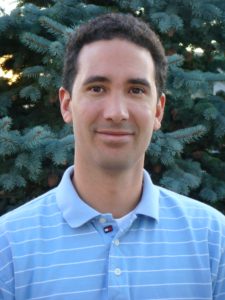
Dr. Nicolas Luco
Nicolas Luco is a Research Structural Engineer with the U.S. Geological Survey (USGS) in Golden, Colorado. He serves as a liaison between the USGS National Seismic Hazard Mapping Project and the American Society of Civil Engineers (ASCE) Seismic Subcommittees for the ASCE 7 and 41 Standards, among other building code committees. Prior to joining the USGS in 2004, he was a Senior Analysis Engineer with the catastrophe risk modeling company AIR Worldwide Corporation. He earned his PhD and BS in civil/structural engineering, and an MS in statistics, from Stanford University; his MS in civil/structural engineering is from the University of California, Berkeley.
Dr. Peter Powers
Peter Powers is a research and development geophysicist at the U.S. Geological Survey. Peter started his career as a geologist and worked in both the mining and tech sectors before attending the University of Southern California, from which he received a PhD in geophysics and seismology. He began his time at the USGS in 2008 as a Global Earthquake Model (GEM) post-doc and developer of OpenSHA and the Uniform California Earthquake Rupture Forecast version 3 (UCERF3). He now develops software and tools to support updates to USGS national hazard models and related research.
Dr. Jorge Meneses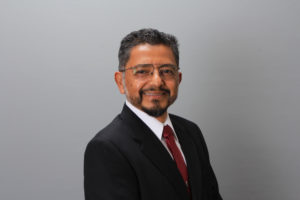
Dr. Jorge Meneses is a Principal Geotechnical Engineer with RMA Grop, Inc. and has more than 30 years of consultancy, project management, research, and teaching experience, in both private industry and research institutions in the field of geotechnical and earthquake engineering. He has been involved in numerous projects serving as a technical lead in geotechnical earthquake engineering and foundation engineering across the country and various markets including water, nuclear, transportation, high rise buildings, energy, schools, hospitals, commercial and industrial. Dr. Meneses frequently acts as a peer reviewer for technical conferences and technical journal publications, is a guest speaker for domestic and international conferences, and has published more than 60 technical publications. He is currently a part-time faculty member in the graduate school of San Diego State University. He is the President and Founder of the Earthquake Engineering Research Institute (EERI) San Diego Chapter, California Seismic Safety Commissioner, Member of the EERI Board of Directors, Honorary Chair of the ASCE Geo-Institute San Diego Chapter, ex-Member of the ASCE 7-16 (Minimum Design Loads for Buildings and Other Structures) and member of the ASCE 1 (Geotechnical Analysis, Design, Construction, Inspection and Monitoring of Nuclear Safety-Related Structures) Committees, member of the Industry Advisory Board, Department of Structural Engineering (University of California San Diego), member of the Academy of Geo-Professionals, and a Fellow of the American Society of Civil Engineers (ASCE).
PROGRAM
| Time | Topic |
|---|---|
| 8:00am–9:00am | Registration and Breakfast |
| 9:00am–9:15am | Welcome and Overview of Program |
| 9:15am–9:45am | ASCE 7-16 Site-Specific Ground Motion Requirements Jorge Meneses |
| 9:45am–10:45am | USGS Unified Hazard Tool and NSHMP-HAZ Web Services for Site-Specific Hazard Curves and Deaggregation Peter Powers |
| 10:45am–11:00am | Morning Break |
| 11:00am–12:00pm | USGS NSHMP-HAZ Code for Site-Specific Analysis Peter Powers |
| 12:00pm–1:00pm | Lunch |
| 1:00pm–1:30pm | USGS Risk-Targeted Ground Motion Calculator Nico Luco |
| 1:30pm–3:00pm | USGS Resources for Deterministic Ground Motion Calculation Nico Luco and Peter Powers |
| 3:00pm–3:15pm | Afternoon Break |
| 3:15pm–4:00pm | Use of USGS Software for ASCE 7-22 Ground Motions Nico Luco |
| 4:00pm–4:30pm | Other USGS Software, including OpenSHA and Seismic Design Web Services Nico Luco and Peter Powers |
| 4:30pm–5:00pm | Discussion of Future USGS Software |
VENUE
San Diego State University
Room: Hardy Tower 140
5500 Campanile Drive
San Diego, CA 92182
Click here for an interactive map of the venue.
Click here for parking information. Please park in Parking Structure 12, 7, or 3.
REGISTRATION
Click here to register for the event.
LODGING
Click here for a list of hotels near San Diego State University.
Click here for an additional list of a series of hotels (Hotel Circle) located ~12 minutes driving distance from the venue.
TRANSPORTATION
Click here for a transportation map from Hotel Circle to the venue.
Transportation to and from the venue can also be utilized through Uber or Lyft.
ORGANIZING COMMITTEE
Dr. Jorge Meneses
Janna Bonfiglio
Alvaro Celestino
Maryam Motamed
Tasneem Sadeque
Elainey Fetene
Athul Parayancode
Metehan Gumustekin
ASCE EERI Joint Luncheon
THE PROMISE OF SMART MATERIALS IN EARTHQUAKE RESISTANT DESIGN
Tuesday, February 26th, 2019
11:30am-1:30pm
Hilton San Diego Mission Valley
San Diego, CA
Join EERI in a joint luncheon with ASCE San Diego Section, featuring guest speaker Dr. Reginald DesRoches, EERI 2018 Distinguished Lecturer. The presentation will discuss the use of smart materials in bettering structural performance against seismic activity.
For members of EERI and ASCE = $35.00
For non-members = $45.00
For public agency workers = $20.00
For students or lifetime members = $15.00
For more information, click the images below to view event flyers:
REGISTRATION
Click here to register for the luncheon.
VENUE
Hilton San Diego Mission Valley
901 Camino Del Rio South
San Diego, CA 92108
2018 December Dinner Meeting
EARTHQUAKE INSURANCE
Monday, December 10th, 2018
6:00pm-8:30pm
San Diego State University, Faculty-Staff Club
San Diego, CA
Free Parking
 The topic of this dinner meeting is “Earthquake Insurance” with two distinguished speakers: Ms. Janiele Maffei, California Earthquake Authority, and Andrew Tran, Swiss Re. Further information on the talks and brief biographies of the speakers are presented below.
The topic of this dinner meeting is “Earthquake Insurance” with two distinguished speakers: Ms. Janiele Maffei, California Earthquake Authority, and Andrew Tran, Swiss Re. Further information on the talks and brief biographies of the speakers are presented below.
For members of EERI, ASCE, SEOSD, SDAG, AIA = $35.00
For non-members = $40.00
Click image on right to view event flyer.
REGISTRATION
Click here to register for the meeting.
PRESENTATIONS
CEA Earthquake Insurance for Homeowners, by Janiele Maffei
In 1996, the California Legislature went one step further and created the California Earthquake Authority (CEA)—a not-for-profit, publicly managed, privately funded entity. CEA places a high priority on educating California homeowners and renters about how to stay safe during an earthquake, and how to reduce the risk of earthquake damage and loss.
The CEA’s Chief Mitigation Officer developed earthquake guidelines which created statewide retrofit standards that are used to reduce earthquake damage in single-family dwellings. The CEA Mitigation Department manages multiple projects focused on expanding mitigation resources to homeowners and technical professionals; these projects also support the mitigation-related insurance-premium discount for CEA policyholders.
About 76 percent of California residential property insurance companies offer CEA earthquake policies. By selling our policies exclusively through these participating insurance companies, CEA has become one of the largest providers of residential earthquake insurance in the world.
Natural Catastrophe Gap, by Andrew Tran
At Swiss Re, our vision statement is “We make the world more resilient”: one area of focus is Natural Catastrophe Protection Gap. Improved science and granular data along with sophisticated risk and financial models; we are taking steps to close the protection gap.
SPEAKERS
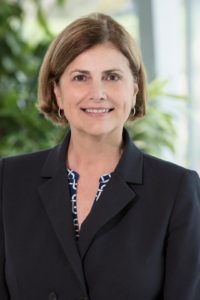 Janiele Maffei, Chief Mitigation Officer, California Earthquake Authority, Sacramento, CA
Janiele Maffei, Chief Mitigation Officer, California Earthquake Authority, Sacramento, CA
As Chief Mitigation Officer of the CEA, Janiele Maffei is responsible for planning and directing the statewide residential retrofit program; leading the processes of developing and promoting educational programs that stress the importance of mitigation; collaborating with academic institutions, and industries to promote and support mitigation research and activities; and other actions that promote seismic mitigation and support mitigation-related insurance-premium discount for CEA policyholders.
Ms. Maffei also serves as the Executive Director of the California Residential Mitigation Program, a Joint Power Authority of the CEA and Governor’s Office of Emergency Services since its inception in August 2011. She is a registered structural engineer who has worked in the earthquake engineering industry for over 36 years. Her experience includes the design of new building structures and seismic strengthening of existing structures. Ms. Maffei earned her AB in Architecture and M.S. in Civil Engineering from the University of California at Berkeley.
Ms. Maffei served on EERI director board from 2012 to 2018. She worked on the organizing committee of the 2010 EERI Annual Meeting in San Francisco. She is a member of the Structural Engineers Association of California and served on their Board from 1995-1997. She participated in post-earthquake reconnaissance investigations following the Loma Prieta, Northridge, and South Napa earthquakes.
Andrew Tran, Senior Vice-President, Swiss Re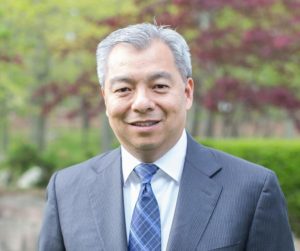
Andy is a Senior Vice President and Head Property Underwriting for US Core Partners Group at Swiss Re. One of his main responsibilities is to manage the underwriting of the Property reinsurance treaty portfolio. Outside of Swiss Re, Andy serve the as a commissioner on the California Seismic and Safety Commission and vice chairman of the Extreme Events Committee as part of the American Academy of Actuaries.
Since joining Swiss Re in 1996, he has held many lead roles including pricing property and casualty reinsurance business, managing loss reserve estimates, and financial reporting including actuarial opinions. And prior to joining Swiss Re, Andy was with Fireman’s Fund Insurance Company and Sullivan Brokerage Companies.
Andy graduated from the University of California of Los Angeles with a BS in Applied Mathematics and Science. He is an Associate of the Casualty Actuarial Society (ACAS), a Member of the American Academy of Actuaries, and Chartered Property and Casualty Underwriter (CPCU).
VENUE
Faculty-Staff Club
San Diego State University
5500 Campanile Drive
San Diego, CA 92182
PARKING INFORMATION
Parking is free for attendees. Please park in Levels 1 & 2 (bottom two levels) of Parking Structure 1, which can be seen on SDSU’s interactive map or on Google Maps.
Directions to Parking Structure 1 and the Faculty-Staff Club:
From Interstate 8 East, take Exit 10 at College Avenue. Proceeding south, turn right at the stoplight onto College Avenue. Then, turn left at the next stoplight–as you turn, you will see Parking Structure 1 immediately on your right. The entrances to Levels 1 & 2 will also be on your right; please park on these two floors.
Take the elevator to Level 6. Then, cross the bridge at Level 6 and climb the set of stairs that run next to the Education and Business Administration Building (which will be on your left). Cross the street and proceed to the Faculty-Staff Club.
ORGANIZING COMMITTEE
Chair: Dr. Jorge Meneses
Janna Bonfiglio
Alvaro Celestino
Maryam Motamed
Tasneem Sadeque
Kenji Ishihara Colloquium Series on Earthquake Geotechnical Engineering
“Seismic Settlements”
Friday, August 24, 2018
San Diego State University, Hardy Memorial Tower (HT-140)
San Diego, CA
 The first of this colloquium series will focus on seismic settlements and will take place in the Hardy Memorial Tower at San Diego State University on Friday, August 24 between 8 AM and 5 PM. The topics that will be presented on during the colloquium are oriented towards geotechnical engineers, structural engineers, engineering geologists, architects, civil engineers, researchers, and students. Speakers, that include geotechnical and structural engineers, set to present at this colloquium include Prof. Jonathan Bray, Prof. Kohji Tokimatsu, Prof. Youssef Hashash, Prof. Susumu Yasuda, Craig Comartin, Stephen Harris, and other engineers and professors from the US and Japan.
The first of this colloquium series will focus on seismic settlements and will take place in the Hardy Memorial Tower at San Diego State University on Friday, August 24 between 8 AM and 5 PM. The topics that will be presented on during the colloquium are oriented towards geotechnical engineers, structural engineers, engineering geologists, architects, civil engineers, researchers, and students. Speakers, that include geotechnical and structural engineers, set to present at this colloquium include Prof. Jonathan Bray, Prof. Kohji Tokimatsu, Prof. Youssef Hashash, Prof. Susumu Yasuda, Craig Comartin, Stephen Harris, and other engineers and professors from the US and Japan.
Registration includes breakfast, lunch, and refreshments during the breaks.
Click here for information on each speaker and their presentations.
PROGRAM
Opening Ceremony
| Refreshments/Registration | 7:00am | 8:00am |
| EERI | 8:00am | 8:05am |
| GI | 8:05am | 8:10am |
Session 1 – Moderator: Anthony B. Court, SE, SEAOC Fellow
| Prof. Youssef Hashash (University of Illinois at Urbana-Champaign) | Numerical Modeling and Simulation of Seismic Settlements in Dense Sands | 8:15am | 8:40am |
| Prof. Scott M. Olson (University of Illinois at Urbana-Champaign) | Semi-empirical estimates of shaking-induced settlement in saturated coarse-grained soils with or without a structure | 8:40am | 9:05am |
| Break | 9:05am | 9:10am | |
| Prof. John S. McCartney (University of California, San Diego) | Role of Unsaturated Soil Mechanics in the Prediction of Seismic Compression | 9:10am | 9:35am |
| Prof. Shideh Dashti (University of Colorado Boulder) | Physics-Informed Semi-Empirical Probabilistic Models for Predicting Building Settlement and Tilt on Liquefiable Ground | 9:35am | 10:00am |
| 4 speakers | Discussion Panel | 10:00am | 10:30am |
| Break | 10:30am | 10:45am | |
| Prof. Edward J. Cording (University of Illinois at Urbana-Champaign) | Damage criterion for buildings subjected to lateral displacement and differential settlement | 10:45am | 11:10am |
| Craig D. Comartin, SE (CDComartin, Inc.) | Structural effects of large seismically induced permanent ground displacement | 11:10am | 11:35am |
| Stephen Harris, SE (Simpson Gumpertz & Heger) | ASCE 7-16 provisions on seismic settlements for liquefiable sites | 11:35am | 12:00pm |
| Lunch Break (Provided) | 12:00pm | 1:00pm | |
| 3 speakers | Discussion Panel | 1:00pm | 1:30pm |
Session 2 – Moderator: Dr. Jorge Meneses
| Prof. Jonathan D. Bray (University of California, Berkeley) | Simplified Assessment of Liquefaction-Induced Building Settlement | 1:30pm | 2:00pm |
| Prof. Kohji Tokimatsu (Tokyo Soil Research Co., Japan) | Liquefaction-induced Settlement and Tilting of Buildings with Shallow Foundations from Centrifuge Experiments | 2:00pm | 2:30pm |
| Speakers | Discussion Panel | 2:30pm | 3:00pm |
| Break | 3:00pm | 3:15pm | |
| Garrett Fountain, PE, GE (Tensar International) | Geogrid-Stabilized Gravel Rafts to Mitigate Liquefaction-Induced Differential Settlement | 3:15pm | 3:40pm |
| Dr. James R. Gingery (Hayward Baker, Inc.) | Ground Improvement to Mitigate Seismic Settlement of Buildings | 3:40pm | 4:05pm |
| Prof. Susumu Yasuda (Tokyo Denki University, Japan) | Ground improvement design procedure to mitigate liquefaction-induced settlement of buildings | 4:05pm | 4:30pm |
| Discussion Panel | 4:30pm | 5:00pm | |
VENUE
San Diego State University
Hardy Memorial Tower, Room HT-140
5500 Campanile Drive
San Diego, CA 92182
Click here for an interactive map of the venue.
Click here for parking information. Please park in Parking Structure 12, 7, or 3.
REGISTRATION
Click here to register for the colloquium.
LODGING
Click here for a list of hotels near San Diego State University.
Click here for an additional list of a series of hotels (Hotel Circle) located ~12 minutes driving distance from the venue.
TRANSPORTATION
Click here for a transportation map from Hotel Circle to the venue.
Transportation to and from the venue can also be utilized through Uber or Lyft.
ORGANIZING COMMITTEE
Chair: Dr. Jorge Meneses
Vice-Chair: Prof. Julio R. Valdes
Janna Bonfiglio
Alvaro Celestino
Metehan Gumustekin
Lydia Marshall
Federick Pinongcos
Tasneem Sadeque
For sponsorship opportunities, please contact Dr. Jorge Meneses at jmenesesl@gmail.com.

